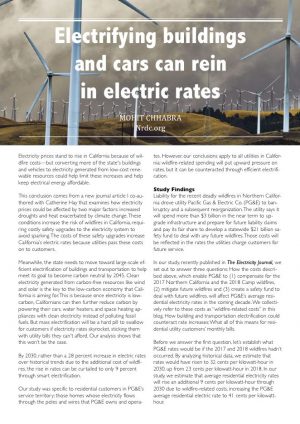 Electricity prices stand to rise in California because of wildfire costs—but converting more of the state’s buildings and vehicles to electricity generated from low-cost renewable resources could help limit these increases and help keep electrical energy affordable.
Electricity prices stand to rise in California because of wildfire costs—but converting more of the state’s buildings and vehicles to electricity generated from low-cost renewable resources could help limit these increases and help keep electrical energy affordable.
This conclusion comes from a new journal article I co-authored with Catherine Hay that examines how electricity prices could be affected by two major factors: increased droughts and heat exacerbated by climate change. These conditions increase the risk of wildfires in California, requiring costly safety upgrades to the electricity system to avoid sparking. The costs of these safety upgrades increase California’s electric rates because utilities pass these costs on to customers.
Meanwhile, the state needs to move toward large-scale efficient electrification of buildings and transportation to help meet its goal to become carbon neutral by 2045. Clean electricity generated from carbon-free resources like wind and solar is the key to the low-carbon economy that California is aiming for. This is because once electricity is low-carbon, Californians can then further reduce carbon by powering their cars, water heaters, and space heating appliances with clean electricity instead of polluting fossil fuels. But mass electrification will be a hard pill to swallow for customers if electricity rates skyrocket, sticking them with utility bills they can’t afford. Our analysis shows that this won’t be the case.
By 2030, rather than a 28 percent increase in electric rates over historical trends due to the additional cost of wildfires, the rise in rates can be curtailed to only 9 percent through smart electrification.
Our study was specific to residential customers in PG&E’s service territory; those homes whose electricity flows through the poles and wires that PG&E owns and operates. However, our conclusions apply to all utilities in California: wildfire-related spending will put upward pressure on rates, but it can be counteracted through efficient electrification.
Study Findings
Liability for the recent deadly wildfires in Northern California drove utility Pacific Gas & Electric Co. (PG&E) to bankruptcy and a subsequent reorganization. The utility says it will spend more than $3 billion in the near term to upgrade infrastructure and prepare for future liability claims and pay its fair share to develop a statewide $21 billion safety fund to deal with any future wildfires. Those costs will be reflected in the rates the utilities charge customers for future service.
In our study, recently published in The Electricity Journal, we set out to answer three questions: How the costs described above, which enable PG&E to (1) compensate for the 2017 Northern California and the 2018 Camp wildfires, (2) mitigate future wildfires and (3) create a safety fund to deal with future wildfires, will affect PG&E’s average residential electricity rates in the coming decade. We collectively refer to these costs as “wildfire-related costs” in this blog. How building and transportation electrification could counteract rate increases; What all of this means for residential utility customers’ monthly bills.
Before we answer the first question, let’s establish what PG&E rates would be if the 2017 and 2018 wildfires hadn’t occurred. By analyzing historical data, we estimate that rates would have risen to 32 cents per kilowatt-hour in 2030, up from 23 cents per kilowatt-hour in 2018. In our study, we estimate that average residential electricity rates will rise an additional 9 cents per kilowatt-hour through 2030 due to wildfire-related costs, increasing the PG&E average residential electric rate to 41 cents per kilowatt-hour.
But we also found that this increase in electric rates can be curtailed to only 35 cents per kilowatt-hour in 2030 through proactive electrification of buildings and transportation—only 3 cents more than what it would’ve been if the wildfires never occurred. That’s because additional electricity sales from adding new electric load on the grid puts downward pressure on electric rates. Utility spending to build, maintain and operate the electric grid are largely fixed costs that form a large portion of our electric rates; the amount we pay our utilities to buy or produce the actual electricity on our behalf is much smaller in comparison.
Generally, increasing the total amount of electricity sales helps to spread the utility’s fixed costs over a larger sales base, which reduces the price of each unit of electricity sold to customers. This is akin to what happens when you spread the same amount of peanut butter over a larger slice of bread; there is less peanut butter in every bite. The answer to how much bigger the slice of bread in our analysis should be—i.e., how much additional electricity consumption from proactive electrification that our study assumes—is 18 percent.
This estimate comes from a California Energy Commission report that, among other things, figured out how much electrification is needed to meet California’s 2045 carbon-neutrality goals. (Read my paper to better understand how the amount of electric sales impact electric rates!)
Finally, we found that electrifying buildings and transportation at this pace through 2030 makes electrification more appealing for all Californians by keeping electricity affordable. The average PG&E residential customer would save $28 a month on electric bills in 2030 compared to a future without this proactive electrification. This result applies to all customers, those who move off fossil fuels to electricity along with those who don’t. The average PG&E customer, who uses around 500 kilowatt-hours per month, pays approximately $115 a month for electricity. This average customer would pay around $160 a month in 2030 due to rate increases in line with historical trends. With wildfire-related costs, this customer could see electricity bills rise to $210 a month. But with efficient electrification in line with our state’s climate goals, that increase can be curtailed to $175.
Let’s not forget that Californians can go even further to keep their electric bills affordable by embracing energy efficiency! It’s also important to remember that not switching to electricity from gas isn’t a good option for Californians because residential gas rates are expected to increase steeply. This is because reduction in gas use due to higher temperatures, driven by climate change, combined with the eye-popping expense of maintaining gas infrastructure creates, means that these increasing infrastructure costs will need to be recovered from declining gas sales.
The results of this study are good news for Californians. By decarbonizing the state’s buildings and transportation, we can clean up sectors that currently account for 60 percent of the state’s greenhouse gas emissions. And we can make electricity more affordable in the process, saving residential customers hundreds of dollars a year.
Mohit Chhabra
Originally published
by NRDC.org
February 19, 2020





